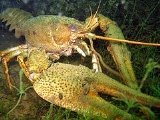
Astacus leptodactylus
Encyclopedia
Astacus leptodactylus, the Danube
crayfish, Galician crayfish, Turkish crayfish or narrow-clawed crayfish is a species
of crayfish
imported and introduced to Central Europe
in 19th century from the Caspian Sea
region.
to the end of the telson
(tail), but is more commonly found at around 15 cm (6 in) in length. The sides of the thorax
are very rough, usually pale yellow to pale green in colour. A. leptodactylus has two pairs of post-orbital ridges, the second of which may have spines. It also has a prominent tubercle (small nodule) on shoulder of the carapace
. The claws of Astacus leptodactylus are long and narrow (hence the common name 'narrow-clawed crayfish'). Their upper surface is rough and the underside is the same colour as the body. A tubercle can be found on the fixed side of the claw. A. leptodactylus can be distinguished most easily from the European or broad-fingered crayfish, Astacus astacus
, by the relatively thinner "fingers" of the claws.
s and canal
s. It is listed as a species of Least Concern
on the IUCN Red List
.
Danube
The Danube is a river in the Central Europe and the Europe's second longest river after the Volga. It is classified as an international waterway....
crayfish, Galician crayfish, Turkish crayfish or narrow-clawed crayfish is a species
Species
In biology, a species is one of the basic units of biological classification and a taxonomic rank. A species is often defined as a group of organisms capable of interbreeding and producing fertile offspring. While in many cases this definition is adequate, more precise or differing measures are...
of crayfish
Crayfish
Crayfish, crawfish, or crawdads – members of the superfamilies Astacoidea and Parastacoidea – are freshwater crustaceans resembling small lobsters, to which they are related...
imported and introduced to Central Europe
Central Europe
Central Europe or alternatively Middle Europe is a region of the European continent lying between the variously defined areas of Eastern and Western Europe...
in 19th century from the Caspian Sea
Caspian Sea
The Caspian Sea is the largest enclosed body of water on Earth by area, variously classed as the world's largest lake or a full-fledged sea. The sea has a surface area of and a volume of...
region.
Description
Astacus leptodactylus can grow up to 30 centimetres (11.8 in) in length from the tip of the rostrumRostrum (anatomy)
The term rostrum is used for a number of unrelated structures in different groups of animals:*In crustaceans, the rostrum is the forward extension of the carapace in front of the eyes....
to the end of the telson
Telson
The telson is the last division of the body of a crustacean. It is not considered a true segment because it does not arise in the embryo from teloblast areas as do real segments. It never carries any appendages, but a forked "tail" called the caudal furca is often present. Together with the...
(tail), but is more commonly found at around 15 cm (6 in) in length. The sides of the thorax
Thorax
The thorax is a division of an animal's body that lies between the head and the abdomen.-In tetrapods:...
are very rough, usually pale yellow to pale green in colour. A. leptodactylus has two pairs of post-orbital ridges, the second of which may have spines. It also has a prominent tubercle (small nodule) on shoulder of the carapace
Carapace
A carapace is a dorsal section of the exoskeleton or shell in a number of animal groups, including arthropods such as crustaceans and arachnids, as well as vertebrates such as turtles and tortoises. In turtles and tortoises, the underside is called the plastron.-Crustaceans:In crustaceans, the...
. The claws of Astacus leptodactylus are long and narrow (hence the common name 'narrow-clawed crayfish'). Their upper surface is rough and the underside is the same colour as the body. A tubercle can be found on the fixed side of the claw. A. leptodactylus can be distinguished most easily from the European or broad-fingered crayfish, Astacus astacus
Astacus astacus
Astacus astacus, the European crayfish, noble crayfish or broad-fingered crayfish, is the most common species of crayfish in Europe, and a traditional foodstuff. Like other crayfish, Astacus astacus is restricted to fresh water, living only in unpolluted streams, rivers and lakes...
, by the relatively thinner "fingers" of the claws.
Ecology
Astacus leptodactylus is fairly docile, especially the male with large claws, and favours relatively still waters such as lakeLake
A lake is a body of relatively still fresh or salt water of considerable size, localized in a basin, that is surrounded by land. Lakes are inland and not part of the ocean and therefore are distinct from lagoons, and are larger and deeper than ponds. Lakes can be contrasted with rivers or streams,...
s and canal
Canal
Canals are man-made channels for water. There are two types of canal:#Waterways: navigable transportation canals used for carrying ships and boats shipping goods and conveying people, further subdivided into two kinds:...
s. It is listed as a species of Least Concern
Least Concern
Least Concern is an IUCN category assigned to extant taxon or lower taxa which have been evaluated but do not qualify for any other category. As such they do not qualify as threatened, Near Threatened, or Conservation Dependent...
on the IUCN Red List
IUCN Red List
The IUCN Red List of Threatened Species , founded in 1963, is the world's most comprehensive inventory of the global conservation status of biological species. The International Union for Conservation of Nature is the world's main authority on the conservation status of species...
.

